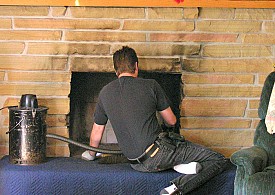How to Get Your Fireplace Ready for Winter
 "Chim chim-i-ney, chim chim-i-ney …" If you loved Walt Disney's Mary Poppins as a child, you're sure to have a soft spot for chimney sweeps. The thought of inviting a colorful Dick van Dyke-esque character to your very own home does have a certain romantic appeal. However, if you'd like to save some cash, you can bypass the sweep's services and take care of cleaning your chimney yourself (mostly). Whichever route you choose -- hiring a professional or DIY -- just make sure that the essential tasks of fireplace maintenance do get done. Sitting in front of a softly glowing blaze with your partner or favorite pet is one of winter's great pleasures, but if the fireplace has been neglected, you could well be playing with fire.
"Chim chim-i-ney, chim chim-i-ney …" If you loved Walt Disney's Mary Poppins as a child, you're sure to have a soft spot for chimney sweeps. The thought of inviting a colorful Dick van Dyke-esque character to your very own home does have a certain romantic appeal. However, if you'd like to save some cash, you can bypass the sweep's services and take care of cleaning your chimney yourself (mostly). Whichever route you choose -- hiring a professional or DIY -- just make sure that the essential tasks of fireplace maintenance do get done. Sitting in front of a softly glowing blaze with your partner or favorite pet is one of winter's great pleasures, but if the fireplace has been neglected, you could well be playing with fire.
Start with the Chimney
Good fireplace care starts with the chimney, since it holds the flue that channels smoke safely out of your home. The Minnesota Pollution Control Agency cautions against using your fireplace when there is an excessive buildup of oily grime (called creosote) inside the chimney, a leading cause of home heating fires -- and not the cozy kind. This means you or your chimney sweep will need to climb up on your Minneapolis roof to clean out the flue before the first fire of the season. But do check the shape of your flue first -- is it round or square? Then go to the hardware store for a chimney cleaning kit, containing rods, extensions, and brushes. Use a plastic drop cloth to cover your hearth in order to catch whatever gunk may fall down. After that, head up to the roof and use the brush to rub the creosote and other dirt loose from the sides of the flue. You may come across a "surprise" -- a nest that was built by birds in your chimney. CAUTION: Nests or small animals may require professional removal.
From the Bottom Up
Now you're ready for the inside job. Get out your vacuum cleaner and insert the hose into the chimney as far as it will go to clear out the loosened grime. Clean the damper (the metal plate that closes your flue when you are not using the fireplace) and the smoke shelf (a shelf built into the chimney to catch falling debris such as dead leaves) as well. It will be hard to tell when you're completely done due to the dark interior, so grab a flashlight and a mirror to help you inspect the results of your handiwork. Finally, clean up the hearth. Bundle the drop cloth into the garbage, together with all the mess it caught, and vacuum up any remaining soot, ash, and dust.
Inspect the Structure
Look to see whether your chimney has an exterior steel cap. If not, you had better get one installed ASAP. The cap covers the chimney not only to keep birds and other animals, rain, or snow out of the flue, but also to keep sparks in. This prevents flying sparks from setting your roof on fire. Look over the structure of the chimney and fireplace to see whether any mortar is cracked, chipped or missing. If so, dig out the loose mortar and brush the brick surface with water. Prepare a batch of fresh mortar and use a trowel to pack it firmly into the holes, then let it dry for at least 24 hours before using the fireplace. Finally, check for signs of leakage or water stains. Should you spot any of these, your best course of action is contacting a chimney or roofing professional immediately to avoid serious problems.
Laura Firszt writes for networx.com.
Looking for a Pro? Call us (866) 441-6648

Roofing Average Costs
Roofers Experiences

Roof Repair To Keep Out Miami Rainstorms

Emergency Plumbing Repair Of Collapsed Sewer Pipe



